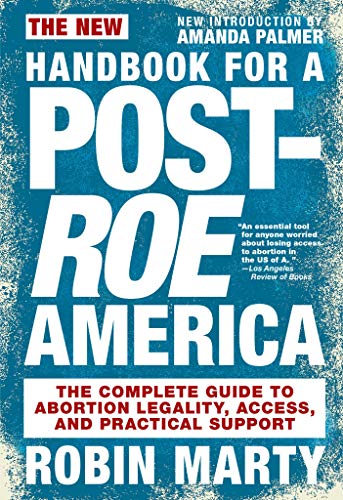by Melanie Holmes
When SCOTUS overturned Roe v. Wade on June 24, 2022, reproductive freedom activists wondered, “What now?” The answer: there have been people preparing for a post-Roe America for decades, and Robin Marty’s handbook outlines the way forward.
Marty published an earlier version of this handbook in 2018, and she explains an updated version was needed because “When COVID-19 shut everything down (including abortion clinics)…it exposed places where the first edition failed to anticipate what would be needed.”
In this “New” handbook which came out in 2021, Marty identifies the threats to abortion access post-Roe, including restrictive state laws, anti-choice groups, and discrimination against disenfranchised subgroups (e.g., young, poor, LGBTQ, persons of color, and immigrants). In this updated edition, Marty lists specific actions needed to ensure that access continues to the greatest extent possible.
Where We Are and How We Got Here
Marty begins New Handbook for a Post-Roe America by painting the post-Roe landscape and she summarizes how we got here. For example, shortly after the passage of Roe v. Wade in 1973, its dismantling began with passage of the 1976 Hyde Amendment, which blocked people’s use of Medicare for abortion services. With Hyde, the anti-abortion faction used the argument that taxpayers did not want to fund abortion. Simply put, it targeted the impoverished.
As for the political landscape, Marty shows the slow creep of restrictive laws passed by states in recent years — laws meant to create barriers to abortion, including unreasonable (punitive) waiting periods requiring multiple visits to a clinic. Here, Marty cites 2018 research on locations of abortion clinics across the U.S., which showed how most of America was already a “spotted wasteland” with pregnant people living 100+ miles from clinics. Marty provides answers to crucial questions, no matter where you live.
Proactive Actions to Take Now
Chapters 3 and 4 are devoted to actions suggested for any person who can become pregnant. Marty also outlines what to do in the case of an unplanned pregnancy — who to see, where to go (go local or online?) and clarifies the big difference between a clinic and a Pregnancy Resource Center.
With concrete precision, Marty outlines what your needs may be should you find yourself in pursuit of an abortion. She actually names your needs before you realize what they are.
Volunteering, Organizing, Protesting
In New Handbook for a Post-Roe America Marty provides action plans for advocates that will allow them to do the type(s) of activism for which they are best suited. She lists existing groups who are devoted to policy and fundraising support, and she helps you decide where to devote your talent or donations. She also gives guidelines for taking independent actions. Finding your own personal way forward is crucial, and she helps us by asking pointed questions that, in some cases, operate as reality checks.
For those in areas where abortion remains legal, Marty offers ways to keep it that way. She breaks down the politics for those of us just trying to keep up with election cycles. Marty chillingly points out how local city governments have already become abortion clinic gatekeepers across the nation and outlines actions to take.
A Word About Reproductive Justice
Reproductive freedom and justice are disparate, as Marty carefully explains. Reproductive justice focuses on the intersection of all human rights and the most vulnerable, and how that plays out across America. Here, Marty points to research that shows how the lack of access to abortion among low-income people feeds the cycle of poverty — a cycle that is real, hard-edged, and unjust.
Post-Roe, the frequency of prosecutors calling for criminal charges for doctors and the people who receive abortion care will increase. Low-income people and people of color are at a higher risk of criminal prosecution for pregnancy outcomes (including miscarriages) than at any other point in history. What can you do? Marty highlights the way.
Understanding Abortion
In this updated edition, Marty offers accurate, detailed information on how abortion medication works, as well as about self-managed care outside of a clinic. She also offers a history of the long tradition of care among women, some dating back centuries, and some practices from the late 1960s/early ‘70s. Some come with legal risks, and Marty offers information on this as well.
Anti-choice groups work to confuse the facts, and it is important for pregnant people and pro-choice advocates to understand this. Anti-choice groups speak of “infanticide,” and they’ve even redefined when pregnancy begins. Marty offers the science, and a summary of where we are and where we need to go…all in one place. Reading this handbook gave me back my hope.
================
Melanie Holmes is the author of four books. Her first, The Female Assumption: A Mother’s Story, Freeing Women from the View that Motherhood is a Mandate, won a 2014 Global Media Award from the Population Institute in Washington, DC.



Note that this book was named as a top pick for 2024 for Chicagoland’s Barbara’s Bookstore (several locations, from malls to inside historic Macy’s State Street)